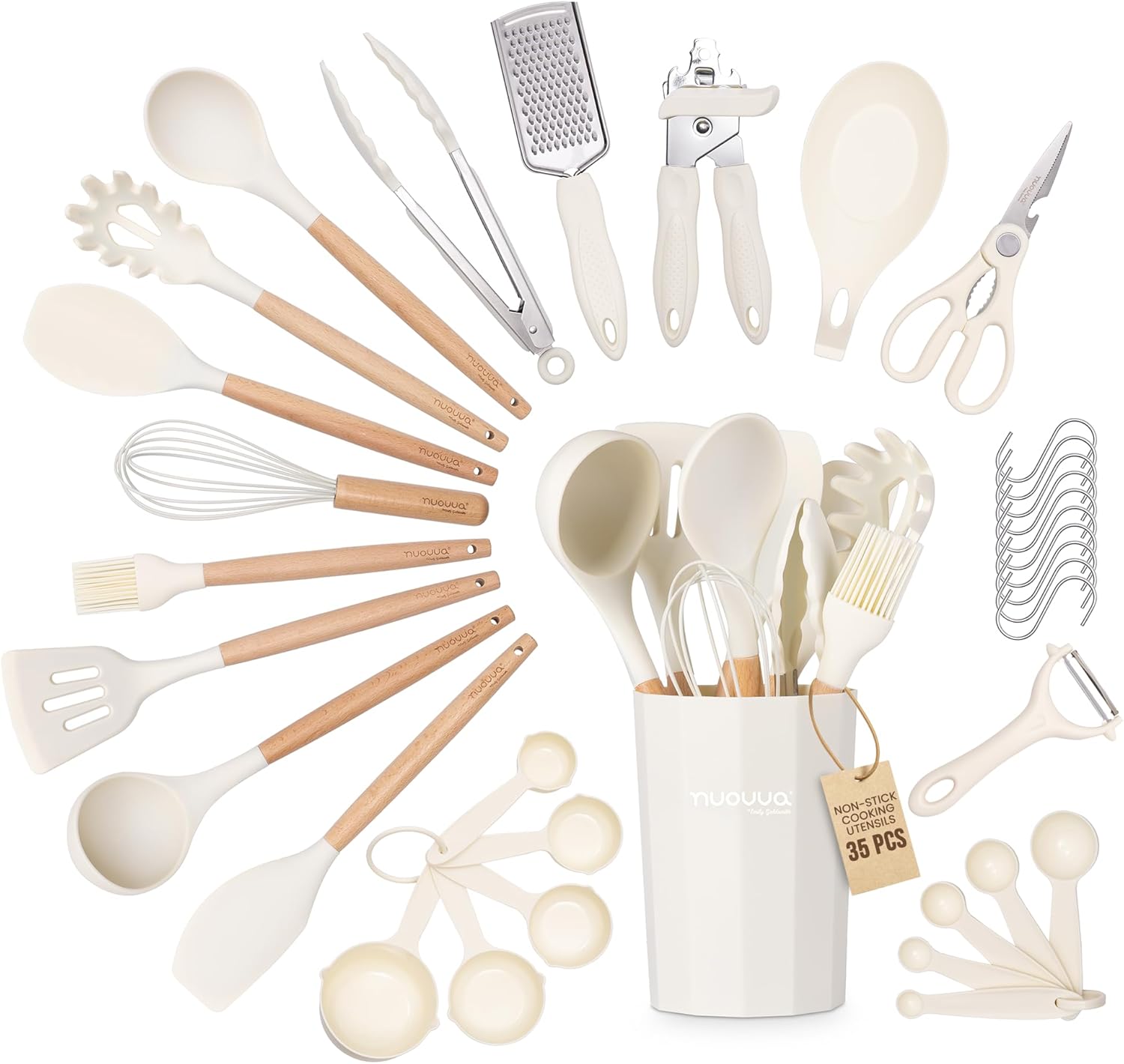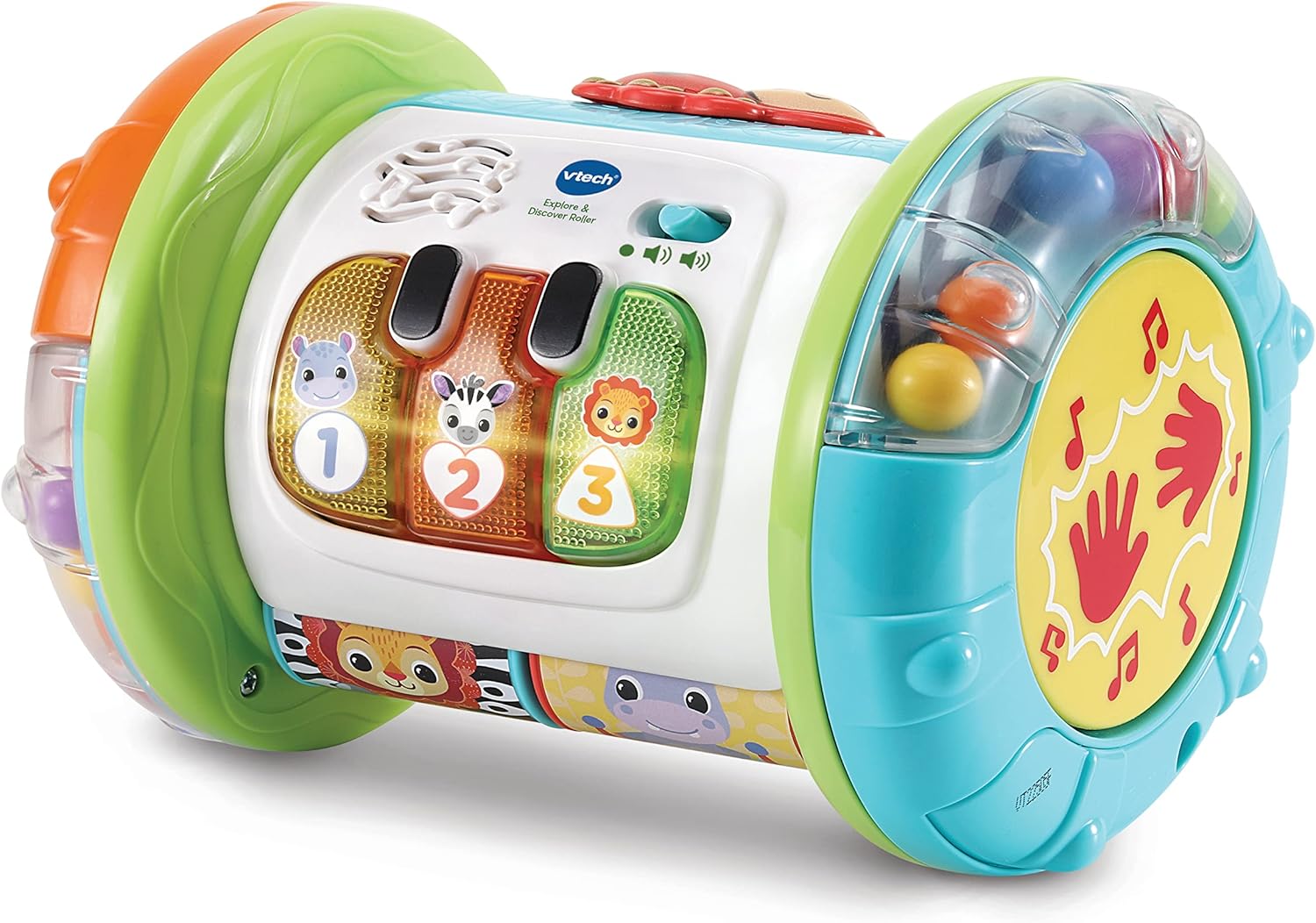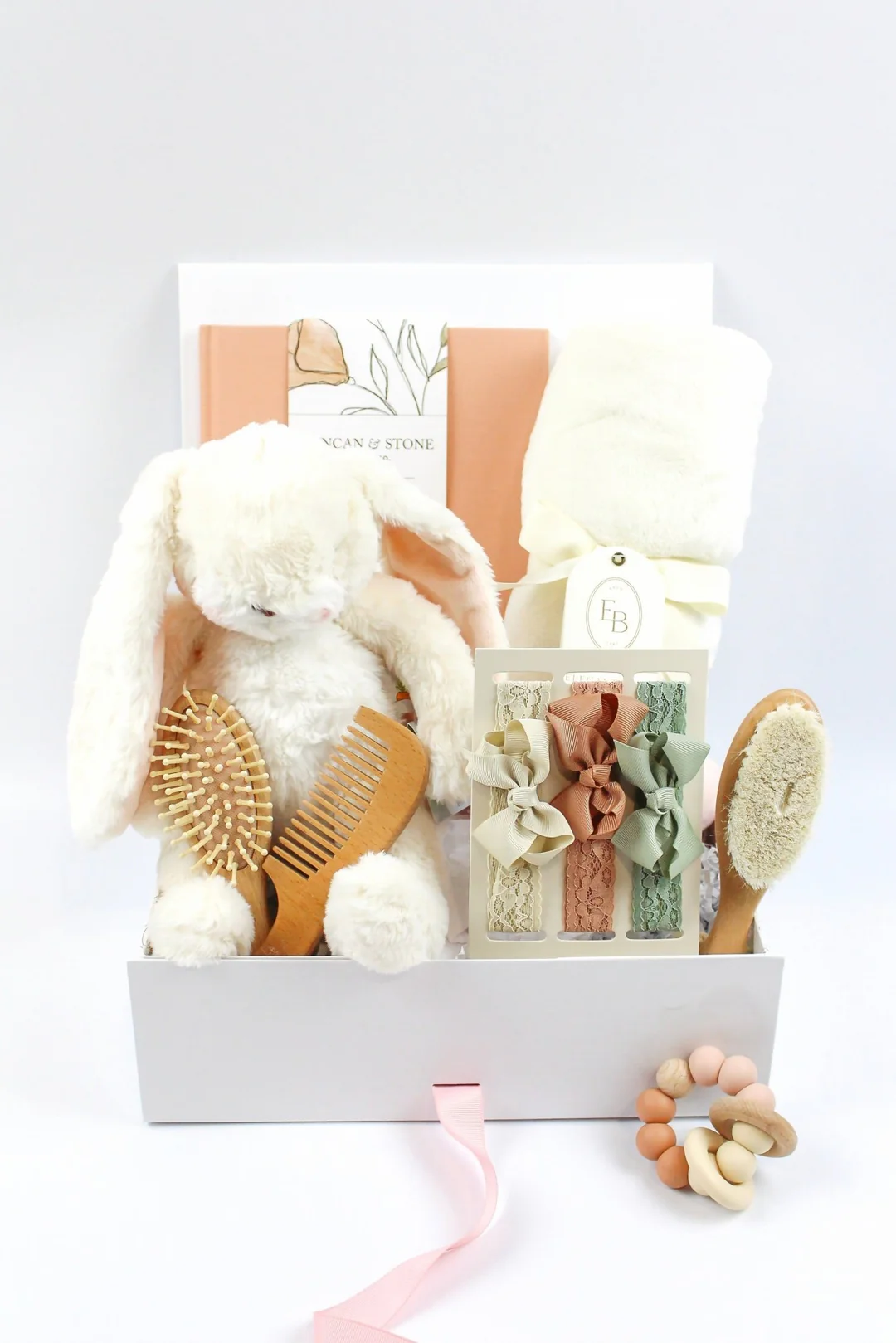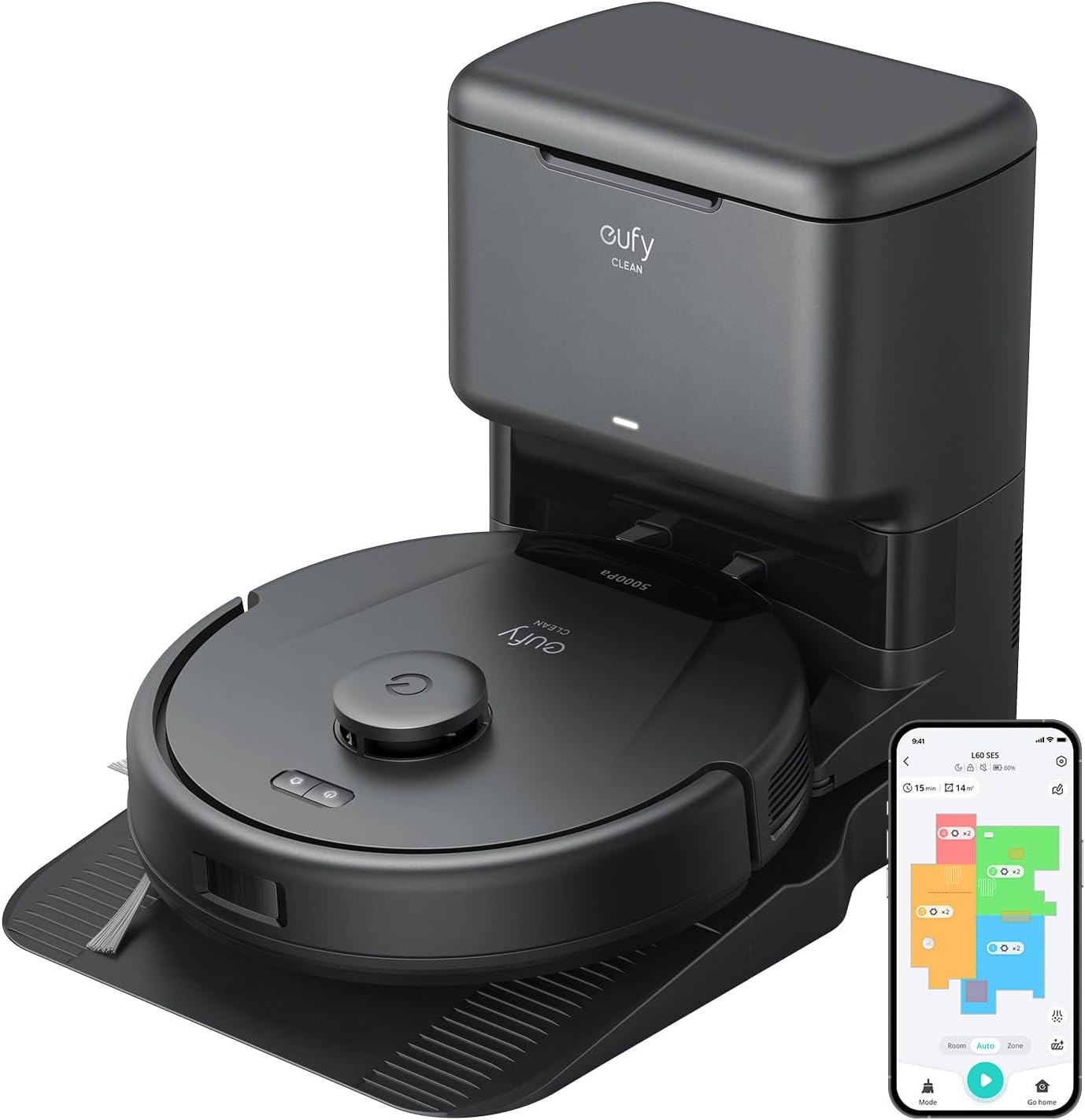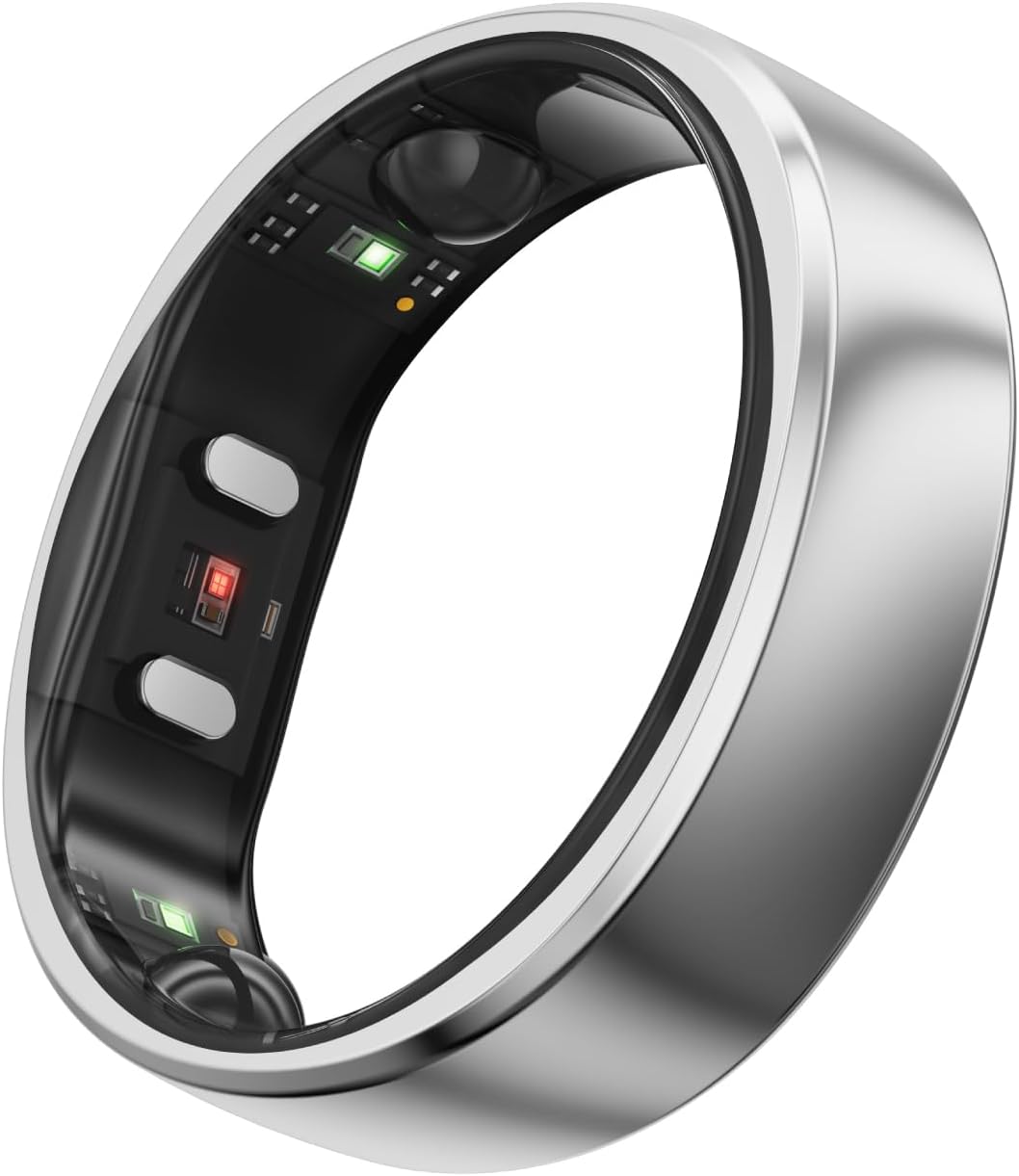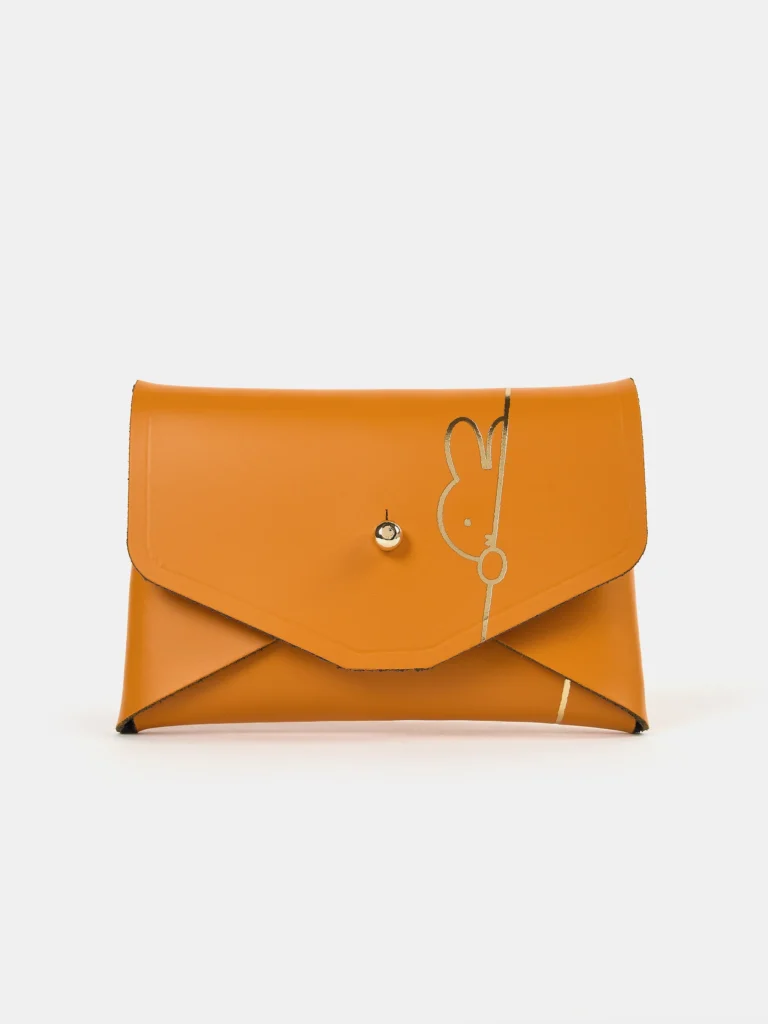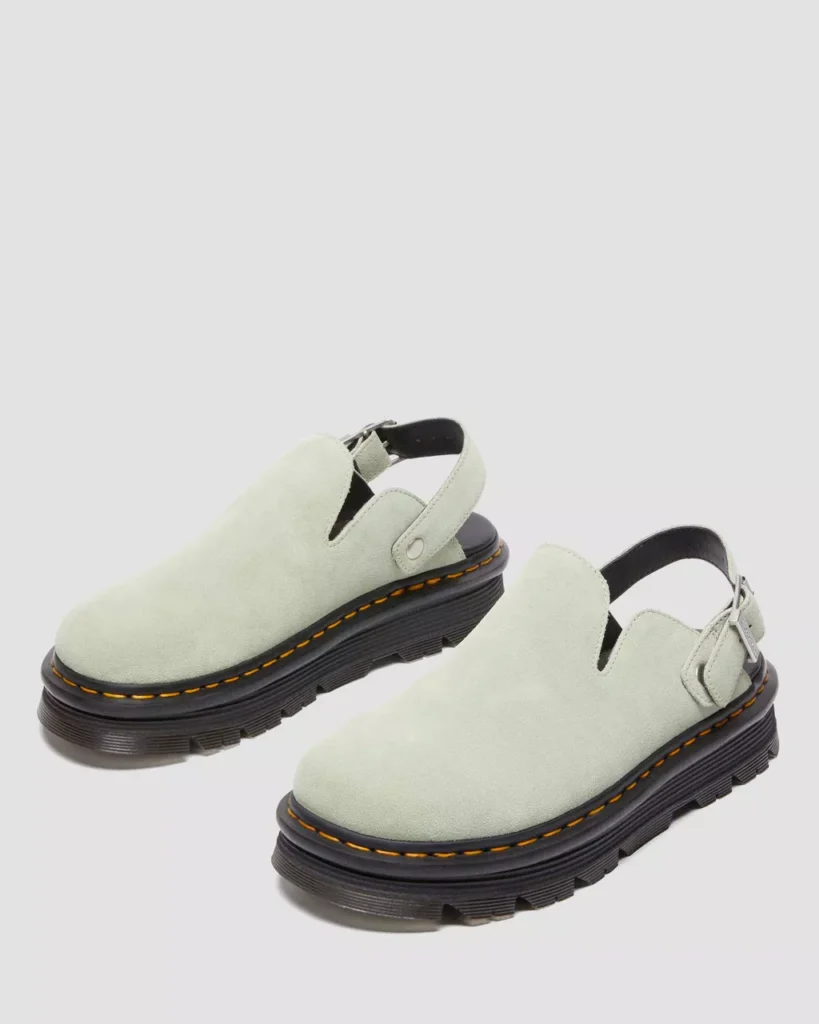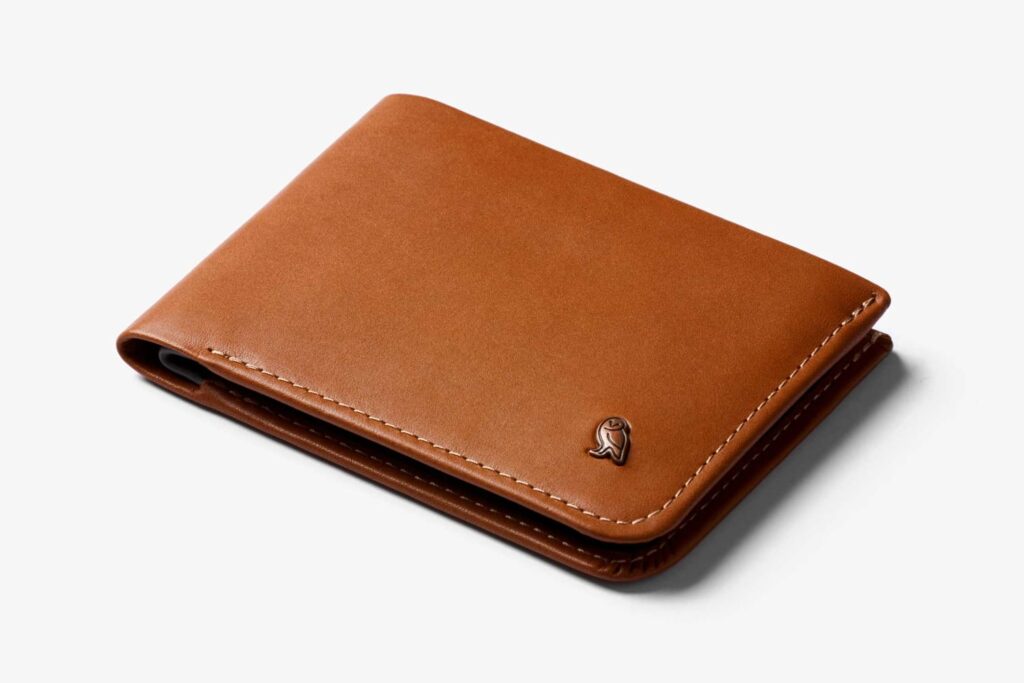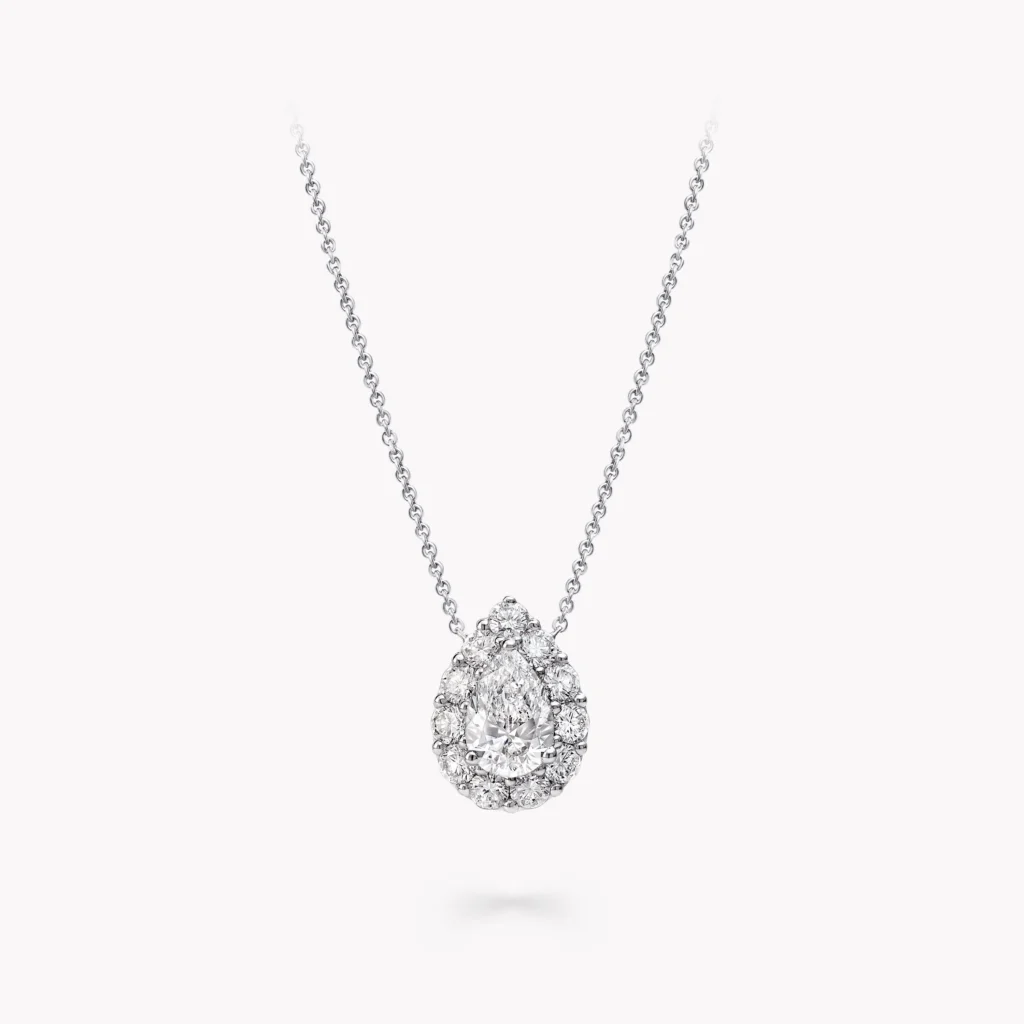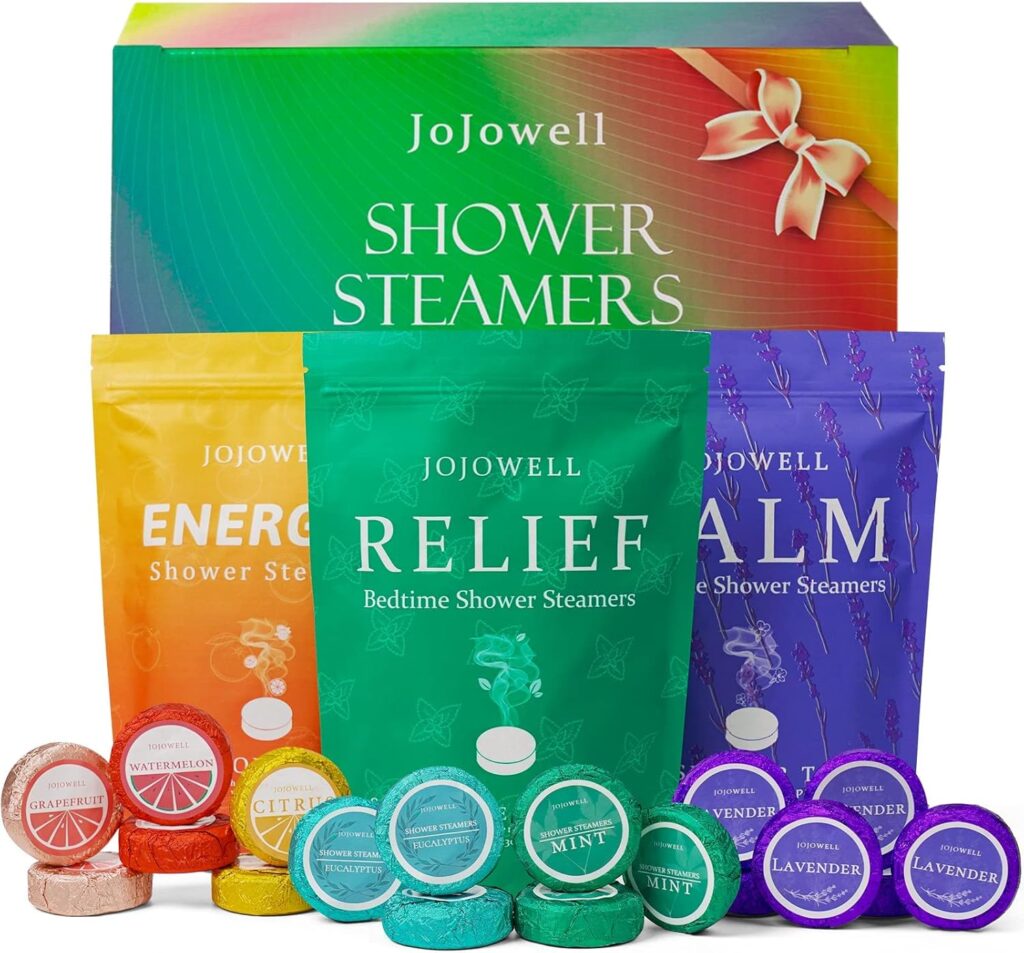There are two kinds of utensil drawers: the clattery museum of mismatched tools and the calm, efficient lineup that makes dinner feel almost… automatic. This guide helps you build the second one. We’ll break down materials, heat ratings, ergonomics, storage, cleaning, and the exact lineup that covers 95% of home cooking—so your pans stay pristine and your dishes turn out consistent. Throughout, we’ll reference the Kitchen Non Stick Cooking Utensils Set as a solid, non-stick-safe foundation you can cook with nightly without babying your cookware.
Shop Kitchen Non Stick Cooking Utensils Set
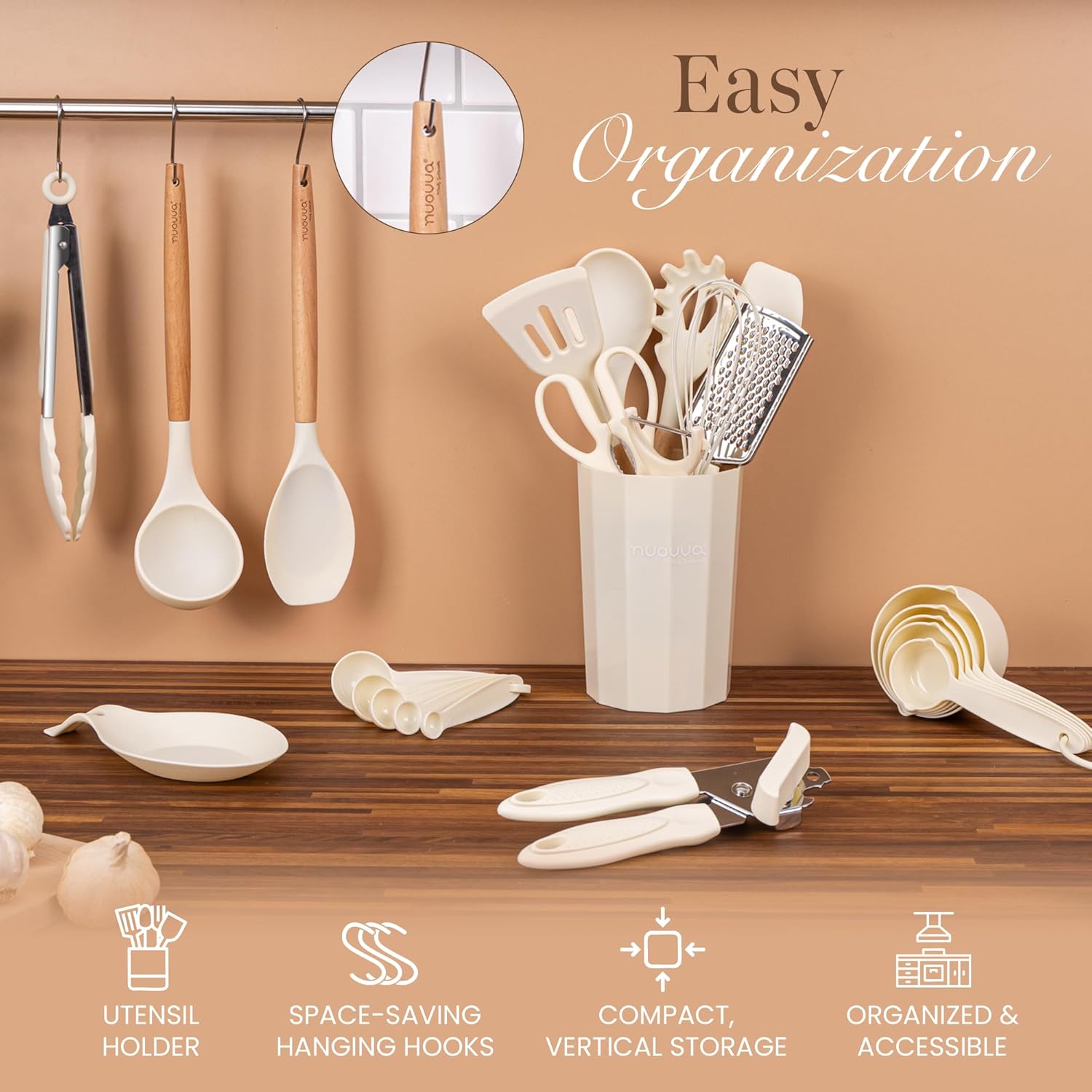
Why Non-Stick-Safe Tools Matter (Even if You Own One Cast-Iron Pan)
Non-stick coatings deliver weeknight wins—fast heat-up, easy release, minimal oil. But metal-on-coating is a short path to scratches and sticky hot spots. A unified silicone/nylon toolset solves that permanently: flexible edges slide under eggs, rounded corners match the curve of sauté pans, and ladles won’t ding your ceramic or enamel. A coordinated set like the Kitchen Non Stick Cooking Utensils Set gives you all the shapes you need with one material logic, so you stop second-guessing, “Will this scratch?”
Materials: Silicone vs. Nylon vs. “Never Metal on Non-Stick”
- Silicone (platinum-cured, BPA-free): Top-tier for non-stick. It’s flexible at the edge, firm in the core (often over a nylon or steel spine), and naturally nonreactive. Heat ratings typically range 200–315°C; look for 230–260°C minimum for pan work.
- Nylon: Affordable, sturdy, but softens above ~200°C. Great for serving and lighter pan use; avoid prolonged high-heat searing.
- Wood/Bamboo: Gentle and charming; can stain and retain odors; hand-wash only.
- Metal: Reserve for stainless or cast-iron. Not for coated pans—ever.
Most modern sets mix silicone heads with reinforced cores to keep them from flopping. The Kitchen Non Stick Cooking Utensils Set follows this playbook: smooth edges for delicate surfaces, enough backbone for stirring thick sauces.
The Minimum Viable Lineup (What You’ll Use Every Week)
A well-designed set should include:
- Slotted turner (fish/eggs/pancakes)
- Solid turner (smash burgers, quesadillas)
- Deep ladle (soups, ramen, batch sauces)
- Slotted spoon (poached eggs, veg)
- Solid spoon (risotto, stews)
- Pasta server (noodle nights simplified)
- Flexible spatula/scraper (batters, jar rescue)
- Tongs with silicone tips (sear, flip, serve)
- Whisk (sauces, dressings)
- Brush (glazes, bakes)
If your set also includes a holder and measuring spoons/cups, that’s bonus organization without another shopping tab. The Kitchen Non Stick Cooking Utensils Set leans into this “cover every task, no duplicates” approach.
Shop Kitchen Non Stick Cooking Utensils Set
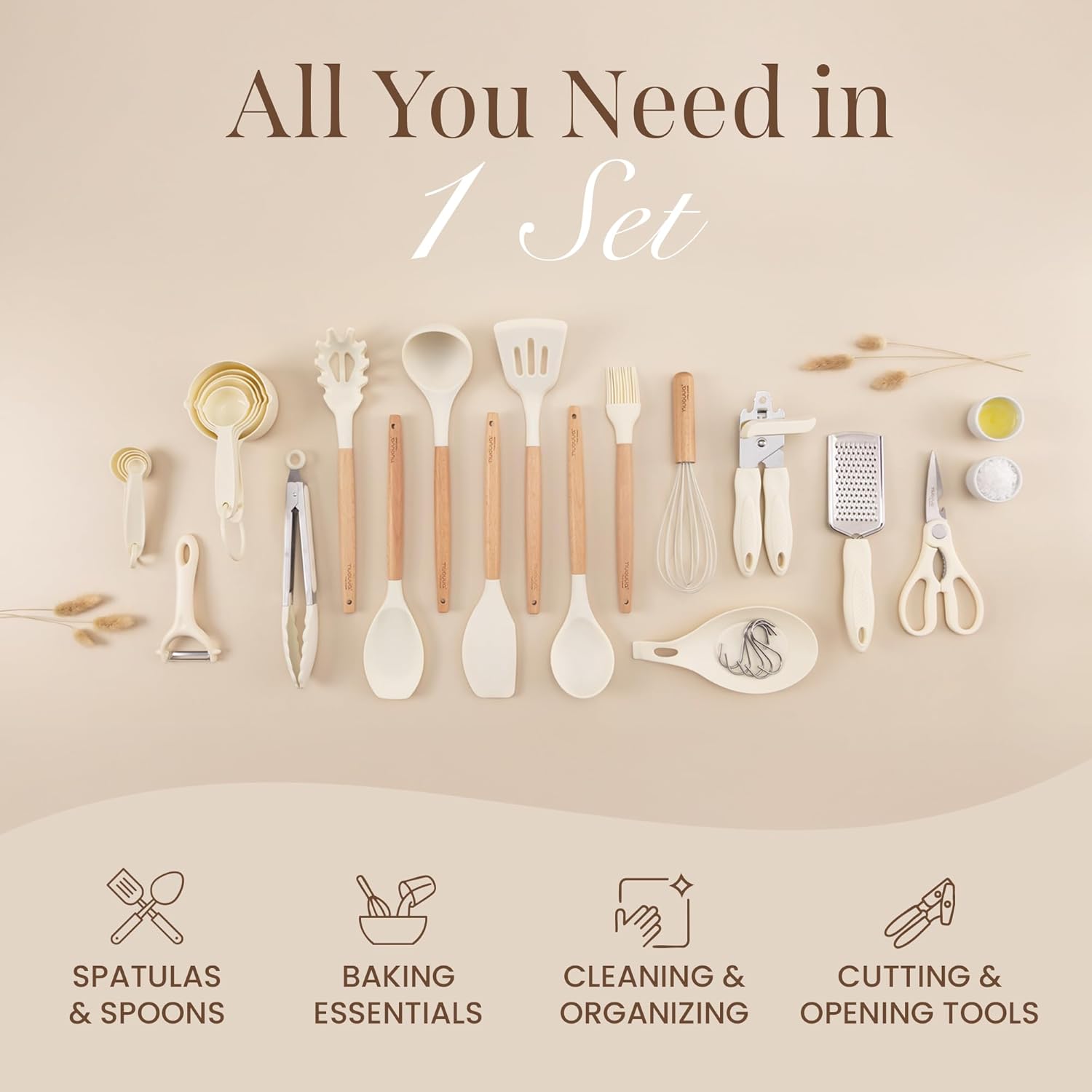
Heat Ratings: What the Numbers Actually Mean
- ≤200°C: Nylon-leaning tools; fine for simmering and serving.
- 230–260°C: Everyday pan work—sauté, stir-fry, pancakes, omelettes.
- >280°C: Safe for oven-adjacent use and brief contact with hotter surfaces (but remember: your pan’s coating may have its own limits).
Rule of thumb: if oil is smoking hard, it’s too hot for your coating and your tools. Reduce the heat, let it stabilize, then continue.
Ergonomics & Control: Little Details, Big Wins
- Edge profile: A thin, beveled silicone edge slides under eggs and crepes without tearing.
- Handle shape: Oval or softly squared handles prevent rolling; a small finger stop improves leverage.
- Weight balance: Head-heavy utensils feel clumsy; balanced tools keep your wrist relaxed during long stirring jobs.
- Tongs with a lock: Saves space and stops drawer snags.
The Kitchen Non Stick Cooking Utensils Set is designed for “grab-and-cook” speed—no guessing which piece is gentle enough for your pan.
Care & Cleaning: Keep Tools—and Pans—Like New
- Avoid dry-pan tool parking. Don’t leave silicone sitting against an empty hot pan for minutes; heat can exceed ratings locally.
- Hand-wash vs. dishwasher: Silicone is usually dishwasher-safe, but hand-washing preserves finishes and avoids detergent haze. If dishwashing, top rack only.
- No scouring pads on heads. A soft sponge does it; for stains, a baking soda paste + warm rinse.
- Air-dry standing. Prevents trapped moisture in the holder.
Storage That Actually Keeps You Cooking
Three smart layouts:
- Counter caddy near the hob: place ladle, slotted spoon, and turner facing out—your “first responders.”
- Wall rail or magnetic strip (for the tongs/whisk if they have metal cores) to free up counter space.
- Drawer grid: divide by task (flip, stir, serve). Keep metal tools in a separate section to avoid accidental pan contact.
A set that ships with a holder (as the Kitchen Non Stick Cooking Utensils Set often does) makes the caddy method effortless: lift, cook, drop, repeat.
Shop Kitchen Non Stick Cooking Utensils Set
Technique Upgrades: Use the Right Tool for the Right Heat
- Eggs & crepes: Medium-low heat + beveled silicone turner. Loosen edges first, then slide under in one smooth motion.
- Stir-fries: High but controlled heat + silicone-edged spatula to scoop and roll ingredients—avoid scraping bare metal.
- Pan sauces: Silicone whisk to deglaze with wine/stock; switch to solid spoon for finishing with butter.
- Pasta nights: Save starchy water with the ladle, then finish in the pan with tongs to emulsify.
These micro-choices reduce sticking, protect coatings, and produce more consistent textures.
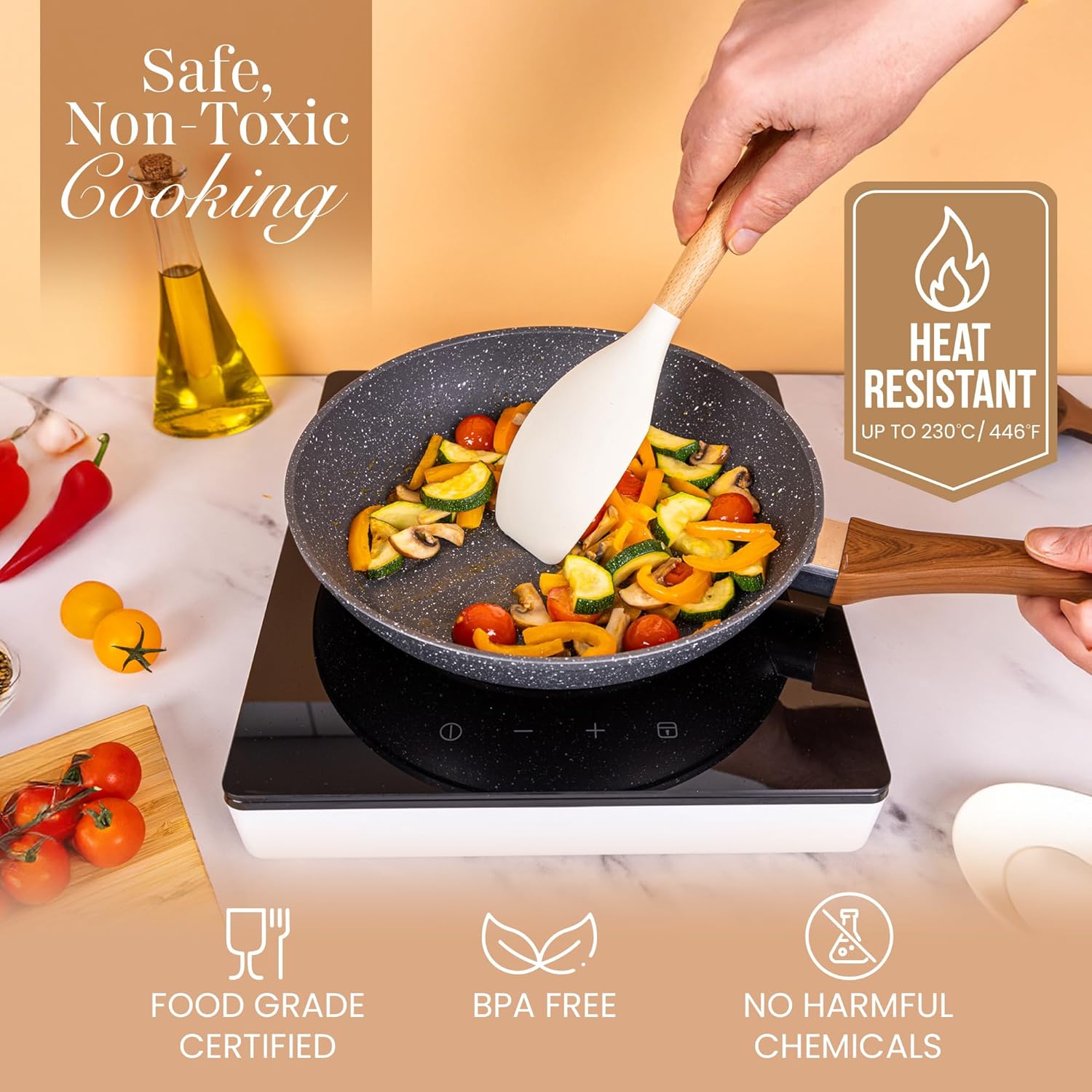
One Hybrid Block (Bullets + Guidance): The Non-Stick “House Rules”
- Preheat gently. Medium heat, then add oil, then food—no dry, smoking pans.
- Silicone only. Metal tools never touch coated surfaces (including the rim).
- Wipe between batches. A quick paper-towel sweep with tongs prevents burnt bits.
- Cool before washing. Thermal shock warps pans and fatigues coatings.
- Stack smart. Place a soft cloth between pans; tools live in the holder, not inside the pan.
Follow these, and your non-stick set—and cookware—will last seasons, not months.
Meal-Prep Scenarios (Where the Set Pays for Itself)
Sheet-pan week: Slotted turner for lifting roasted veg, silicone tongs for chicken thighs, ladle for gravy.
Soup & stew Sunday: Ladle + solid spoon tag-team; whisk for a cornstarch slurry without lumps.
Baking night: Flexible spatula for batter bowls, brush for egg wash, silicone spoon for folding chocolate chips without over-mixing.
Brunch: Turner for pancakes, slotted spoon for poached eggs, tongs for bacon (in a non-stick skillet with gentle heat).
Sustainability & Safety Notes
Choose BPA-free, food-grade silicone with clear heat ratings. A single, durable set replaces years of disposable “meh” tools and cuts down on pan replacements (less landfill, more savings). If handles are wooden, oil lightly with food-safe mineral oil quarterly to prevent cracking; if fully silicone, they’ll shrug off splashes and wipe clean.
Troubleshooting: Quick Fixes to Common Annoyances
- Turner feels too floppy? Use it for eggs/crepes; grab the solid turner or tongs for heavier cuts.
- Food still sticks? Lower heat, add a touch more fat, and let the food release naturally before flipping.
- Lingering tomato/turmeric stains? Make a baking-soda paste, rest 10 minutes, rinse. Sun-dry near a window to fade color.
- Fish keeps breaking? Slide the beveled edge under, then use tongs to support the top of the fillet as you flip.
Shop Kitchen Non Stick Cooking Utensils Set
Budget & Value: Why Sets Beat One-Offs
Buying tools individually tempts duplicates and gaps. A curated set costs less per piece, keeps visual consistency (nice if you store on-counter), and ensures you actually own the shapes you’ll need. If your set includes a holder and measuring tools, that’s two fewer items to source—and zero excuse for the “where did the spatula go?” panic mid-recipe.
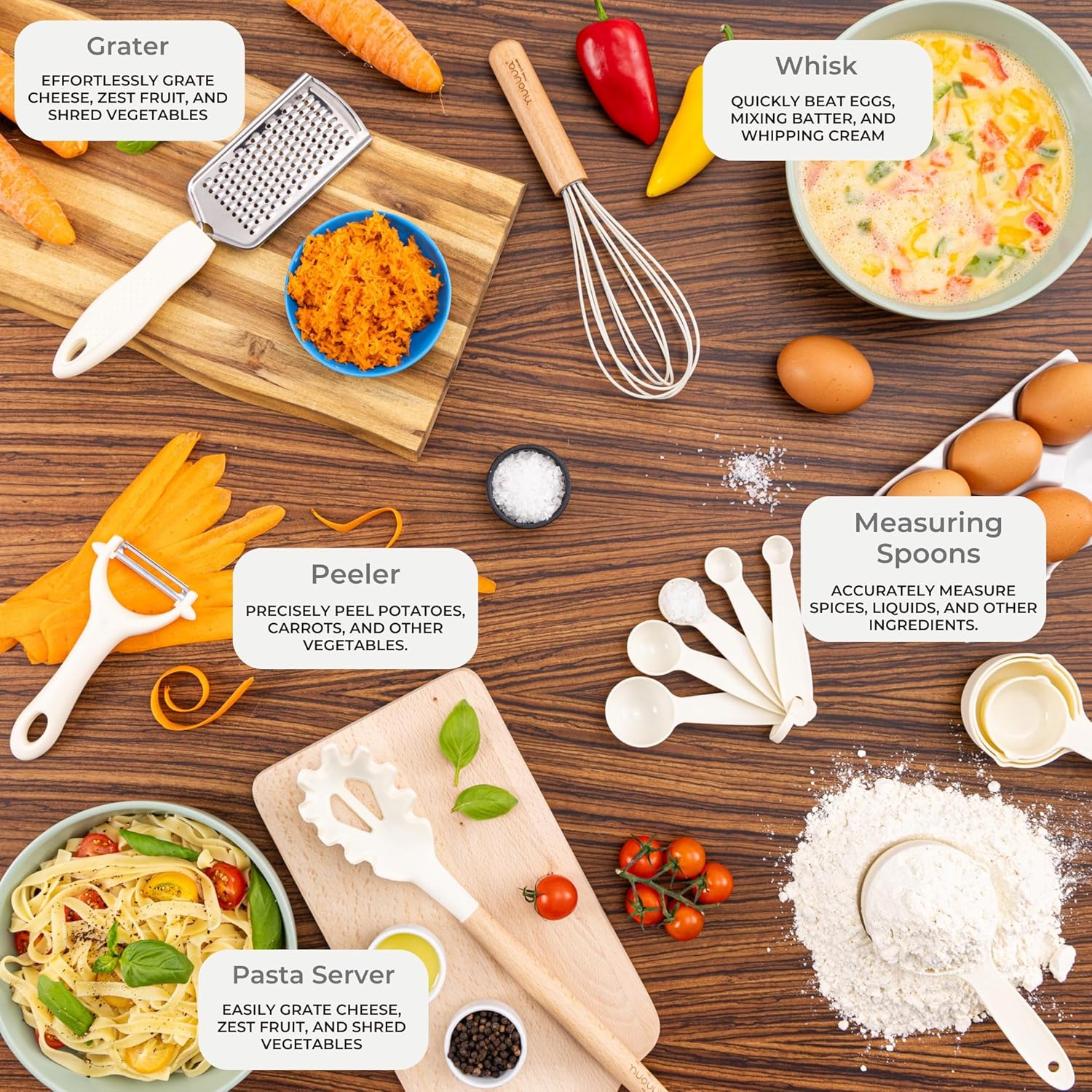
Cleaning Workflow: From Hob to Dry Rack in Two Minutes
- While the pan cools, wipe the heads with a damp paper towel to remove surface oil.
- Warm, soapy rinse; soft sponge only.
- Shake, then air-dry upright in the caddy so water drains away from handles.
- Weekly: empty and wash the caddy; sanitize the holder base so there’s no mystery puddle.
Conclusion
A non-stick-friendly utensil set is the simplest cooking upgrade you can make: better textures, fewer scratches, faster cleanup. Choose heat-rated silicone for pan work, keep an organized caddy by the hob, and follow a few “house rules” to protect coatings. The Kitchen Non Stick Cooking Utensils Set covers the core shapes—turners, spoons, ladle, whisk, tongs—so dinner goes from “where’s that thing?” to muscle memory. Build the system once, cook with confidence nightly, and let your pans stay slick and happy.
Shop Kitchen Non Stick Cooking Utensils Set
FAQ
- Can silicone utensils go in the dishwasher?
Usually yes—top rack preferred. Hand-washing prolongs the finish and prevents detergent haze. - What heat rating should I look for?
Aim for 230–260°C or higher for everyday sautéing. Remember, if oil is smoking, turn the heat down—protects pans and tools. - Are nylon heads safe for high heat?
Great for serving and lower-heat cooking, but they can soften above ~200°C. Use silicone for hot pan work. - Do I still need metal tools?
Keep a metal fish spatula or metal tongs for stainless/cast-iron searing. For non-stick, use silicone/wood only. - How do I stop utensils from staining?
Avoid leaving them sitting in red sauces; clean promptly. Baking-soda paste helps lift stains; sunlight fades turmeric. - What’s the best way to store a full set?
A countertop holder near the hob is fastest. If you’re tight on space, a wall rail + drawer grid combo keeps everything reachable. - Will silicone scratch enamel or ceramic?
No—silicone is gentle on enamelled and ceramic coatings, as well as traditional non-stick. - Do I need two turners?
Yes: a slotted for delicate, oily foods and a solid for heavier flips. It’s not redundancy; it’s precision.

